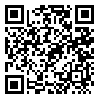Volume 10, Issue 39 And 40 (9-2001)
JGUMS 2001, 10(39 And 40): 8-15 |
Back to browse issues page
Download citation:
BibTeX | RIS | EndNote | Medlars | ProCite | Reference Manager | RefWorks
Send citation to:



BibTeX | RIS | EndNote | Medlars | ProCite | Reference Manager | RefWorks
Send citation to:
Azizi F, Shaikholeslam R, Hedayati M, Mirmiran P, Behlakeh J, Kimiagar M et al . Goiter and Urinary Iodine Concentration in Schoolchildren Aged 8 to 10 Year of Gilan in 1996. JGUMS 2001; 10 (39 and 40) :8-15
URL: http://journal.gums.ac.ir/article-1-2102-en.html
URL: http://journal.gums.ac.ir/article-1-2102-en.html
Abstract: (2685 Views)
Abstract
Iodine deficiency disorders (IDD) is a worldwide health problem. Many parts of the Islamic Republic of Iran had been known as areas of endemic goiter. IDD was accepted as a priority health problem in the country, and a national IDD council was formed in 1989, under the supervision of the Ministry of Health and Medical Education. One of the main strategies of National Council for IDD control was to provide at least 150 mg of iodine per day to the entire population through making available iodized salt. This study was performed to evaluate the national LDD council program in 1996, in rural and urban areas of Gilan. 1350 schoolchildren, aged 8 to 10 year, including 50% girls and 50% boy, were selected through random sampling. Grading of Goiter was performed according to WHOs classification. Serum T3, T4 and TSH were measured by RIA and uninary iodine by digestion method. The mean of serum T4, T3 and TSH were: 10±1.7 µg/dl, 151±71 ng/dl and 2.0±1.5 µlu/ml respectively. There were no differences between males and females and schoolchildren of rural or urban areas. 0.2% had serum T4 more than 12.5 µg/dl, one person had TSH more than 5 µlu/ml. The median iodine was 23 µg/dl in entire population, 94% had urinary iodine more than 10 µg/dl. Only 3% had urinary iodine less than 5µg/dl. Total prevalence of Goiter was 72% (72% in girls and 72% in boys). Based on the available data, seven years after distribution of iodized salt and 2 years after used iodized salt with more than 50% of population , urinary iodine of school children in Gillan is inadequate range. However regarding to prevalence of Goiter in 72% of our study group, Goiter is still hyper endemic in Gillan province.
Iodine deficiency disorders (IDD) is a worldwide health problem. Many parts of the Islamic Republic of Iran had been known as areas of endemic goiter. IDD was accepted as a priority health problem in the country, and a national IDD council was formed in 1989, under the supervision of the Ministry of Health and Medical Education. One of the main strategies of National Council for IDD control was to provide at least 150 mg of iodine per day to the entire population through making available iodized salt. This study was performed to evaluate the national LDD council program in 1996, in rural and urban areas of Gilan. 1350 schoolchildren, aged 8 to 10 year, including 50% girls and 50% boy, were selected through random sampling. Grading of Goiter was performed according to WHOs classification. Serum T3, T4 and TSH were measured by RIA and uninary iodine by digestion method. The mean of serum T4, T3 and TSH were: 10±1.7 µg/dl, 151±71 ng/dl and 2.0±1.5 µlu/ml respectively. There were no differences between males and females and schoolchildren of rural or urban areas. 0.2% had serum T4 more than 12.5 µg/dl, one person had TSH more than 5 µlu/ml. The median iodine was 23 µg/dl in entire population, 94% had urinary iodine more than 10 µg/dl. Only 3% had urinary iodine less than 5µg/dl. Total prevalence of Goiter was 72% (72% in girls and 72% in boys). Based on the available data, seven years after distribution of iodized salt and 2 years after used iodized salt with more than 50% of population , urinary iodine of school children in Gillan is inadequate range. However regarding to prevalence of Goiter in 72% of our study group, Goiter is still hyper endemic in Gillan province.
Keywords: Goiter/ Iodine/ Urine
Review Paper: Research |
Subject:
Special
Received: 2019/04/17 | Accepted: 2019/04/17 | Published: 2019/04/17
Received: 2019/04/17 | Accepted: 2019/04/17 | Published: 2019/04/17
| Rights and permissions | |
 |
This work is licensed under a Creative Commons Attribution-NonCommercial 4.0 International License. |






